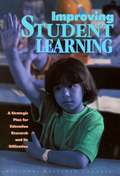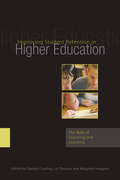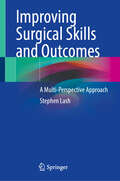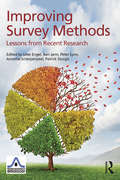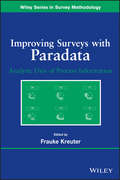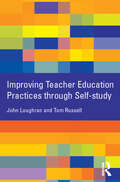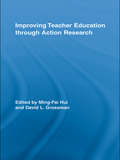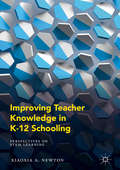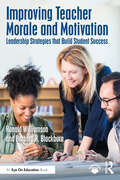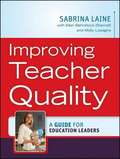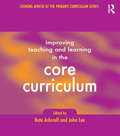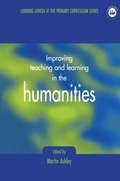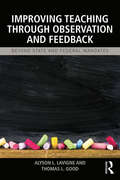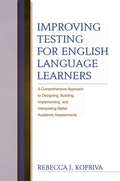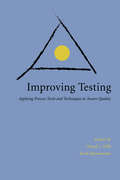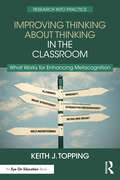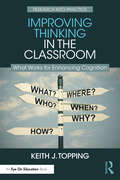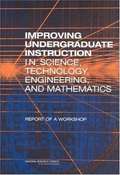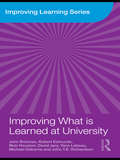- Table View
- List View
Improving Student Learning at Scale: A How-To Guide for Higher Education
by Keston H. Fulcher Caroline PrendergastThis book is a step-by-step guide for improving student learning in higher education. The authors argue that a fundamental obstacle to improvement is that higher educators, administrators, and assessment professionals do not know how to improve student learning at scale. By this they mean improvement efforts that span an entire program, affecting all affiliated students. The authors found that faculty and administrators particularly struggle to conceptualize and implement multi-section, multi-course improvement efforts. It is unsurprising that ambitious, wide-reaching improvement efforts like these would pose difficulty in their organization and implementation. This is precisely the problem the authors address. The book provides practical strategies for learning improvement, enabling faculty to collaborate, and integrating leadership, social dynamics, curriculum, pedagogy, assessment, and faculty development. In Chapter 2, the authors tell a program-level improvement story from the perspective of a faculty member. Chapter 3 inverts Chapter 2. Beginning from the re-assess stage, the authors work their way back to the individual faculty member first pondering whether she can do something to impact students’ skills. They peel back each layer of the process and imagine how learning improvement efforts might be thwarted at each stage. Chapters 4 through 9 dig deeper into the learning improvement steps introduced in Chapters 2 and 3. Each chapter provides strategies to help higher educators climb each step successfully. Chapter 10 paints a picture of what higher education could look like in 2041 if learning improvement were embraced. And, finally, Chapter 11 describes what you can do to support the movement.
Improving Student Learning: A Strategic Plan for Education Research and Its Utilization
by National Research CouncilThe state of America's schools is a major concern of policymakers, educators, and parents, and new programs and ideas are constantly proposed to improve it. Yet few of these programs and ideas are based on strong research about students and teachers--about learning and teaching. Even when there is solid knowledge, the task of importing it into more than one million classrooms is daunting.Improving Student Learning responds by proposing an ambitious and extraordinary plan: a strategic education research program that would focus on four key questions: How can advances in research on learning be incorporated into educational practice?How can student motivation to achieve in school be increased?How can schools become organizations capable of continuous improvement?How can the use of research knowledge be increased in schools? This book is the springboard for a year-long discussion among educators, researchers, policy makers, and the potential funders-federal, state, and private-of the proposed strategic education research program. The committee offers suggestions for designing, organizing, and managing an effective strategic education research program by building a structure of interrelated networks. The book highlights such issues as how teachers can help students overcome their conceptions about how the world works, the effect of expectations on school performance, and the particular challenges of teaching children from diverse and disadvantaged backgrounds.In the midst of a cacophony of voices about America's schools, this book offers a serious, long-range proposal for meeting the challenges of educating the nation's children.
Improving Student Retention in Higher Education: The Role of Teaching and Learning
by Liz Thomas Glenda Crosling Margaret HeagneyImproving Student Retention in Higher Education provides a practical, curriculum-based response to the current situation in higher education, where participating students emanate from a range of backgrounds; international and lower socioeconomic backgrounds, mature aged students, students with disabilities as well as those for whom higher education is the first family experience. Underpinned by research indicating that students are more likely to continue with higher education if they are engaged in their studies and have developed networks and relationships with their fellow students, this book presents best practice examples of innovative and inclusive curriculum, from a range of countries.
Improving Students' Writing, K-8: From Meaning-Making to High Stakes!
by Diane Barone Joan M. TaylorThis manual for teaching all aspects of writing provides examples, rubrics, and how-to's for helping students grow in skills and write for high stakes and "constructed response" tests.
Improving Subject Teaching: Lessons from Research in Science Education (Improving Learning)
by John Leach Robin Millar Jonathan Osborne Mary RatcliffeIn many countries, questions are being raised about the quality and value of educational research. This book explores the relationship between research and practice in education. It looks at the extent to which current practice could be said to be informed by knowledge or ideas generated by research and at the extent to which the use of current practices or the adoption of new ones are, or could be, supported by research evidence. Science education is used as a case study but the issues considered apply to the teaching and learning of any curriculum subject. The book draws on the findings of four inter-related research studies and considers: how research might be used to establish greater consensus about curriculum; how research can inform the design of assessment tools and teaching interventions; teachers’ and other science educators’ perceptions of the influence of research on their teaching practices and their students’ learning; the extent to which evidence can show that an educational practice ‘works’.
Improving Surgical Skills and Outcomes: A Multi-Perspective Approach
by Stephen LashDrawing on 25 years of experience, Consultant surgeon Mr Stephen Lash offers a fresh approach to the practice of surgery. His three perspectives or ‘Boxes’ explore the ‘How’ the ‘What’ and the ‘Why’ of surgery drawing lessons from Elite athletes to Toyota and from pilots to personality. Each box contributes a novel perspective to the surgeon’s learning and practice and offers practical tips to apply in theatre. It is easy to read and designed to be used alongside training and stimulate interesting conversations during the surgical debrief, best served with coffee. “There are endless books about surgical technique, but a woeful lack of information on how to be a surgeon. This book helps fill that gap.” Prof Andrew Luff MA, MBBS, FRCS, FRCOphth Consultant Ophthalmic Surgeon “I am convinced that it will not only appeal to the surgeons for which it was written but to a wider public as well. After all what is an operating theatre if not an open window on the real world?” Giampaolo Gini MD PhD President of the European Vitreo-Retinal Society This book is an ideal companion to surgeons everywhere from Dentists on the high street to Consultants in specialist units, medical students to key opinion leaders and anyone interested in this particular type of person willing to cut into another in pursuit of wholeness.
Improving Survey Methods: Lessons from Recent Research (European Association of Methodology Series)
by Uwe Engel Ben Jann Peter Lynn Annette Scherpenzeel Patrick SturgisThis state-of-the-art volume provides insight into the recent developments in survey research. It covers topics like: survey modes and response effects, bio indicators and paradata, interviewer and survey error, mixed-mode panels, sensitive questions, conducting web surveys and access panels, coping with non-response, and handling missing data. The authors are leading scientists in the field, and discuss the latest methods and challenges with respect to these topics. Each of the book’s eight parts starts with a brief chapter that provides an historical context along with an overview of today’s most critical survey methods. Chapters in the sections focus on research applications in practice and discuss results from field studies. As such, the book will help researchers design surveys according to today’s best practices. The book’s website www.survey-methodology.de provides additional information, statistical analyses, tables and figures. An indispensable reference for practicing researchers and methodologists or any professional who uses surveys in their work, this book also serves as a supplement for graduate or upper level-undergraduate courses on survey methods taught in psychology, sociology, education, economics, and business. Although the book focuses on European findings, all of the research is discussed with reference to the entire survey-methodology area, including the US. As such, the insights in this book will apply to surveys conducted around the world.
Improving Surveys with Paradata
by Frauke KreuterExplore the practices and cutting-edge research on the new and exciting topic of paradataParadata are measurements related to the process of collecting survey data.Improving Surveys with Paradata: Analytic Uses of Process Information is the most accessible and comprehensive contribution to this up-and-coming area in survey methodology.Featuring contributions from leading experts in the field, Improving Surveys with Paradata: Analytic Uses of Process Information introduces and reviews issues involved in the collection and analysis of paradata. The book presents readers with an overview of the indispensable techniques and new, innovative research on improving survey quality and total survey error. Along with several case studies, topics include:Using paradata to monitor fieldwork activity in face-to-face, telephone, and web surveysGuiding intervention decisions during data collectionAnalysis of measurement, nonresponse, and coverage error via paradataProviding a practical, encompassing guide to the subject of paradata, the book is aimed at both producers and users of survey data. Improving Surveys with Paradata: Analytic Uses of Process The book also serves as an excellent resource for courses on data collection, survey methodology, and nonresponse and measurement error.
Improving Teacher Education Practice Through Self-study
by Tom Russell John LoughranSelf-study in teacher education is a growing field and a natural progression from the concept of reflective practice for pre-service teachers. This book is designed to introduce teacher educators to the theory and practice of self-study, in order to explore, understand and improve their teaching about teaching.With studies from an international range of contributors, this book illustrates a variety of approaches to self-study. It describes the issues that teacher educators have chosen to study, how they carried out their research and what the learning outcomes were. Throughout, the emphasis is on placing teacher educators' knowledge and practice at the centre of their academic work.This book will be of interest to all teacher educators wishing to improve their knowledge and practice.
Improving Teacher Education through Action Research (Routledge Research in Education)
by Ming-Fai Hui David L. GrossmanThere has been a dearth of studies on teacher educators using action research to improve their own practice. This book is the first systematic study of a group of teachers examining and enhancing their own practice through the inquiry process of action research. This book presents a broad overview of a variety of methodologies that can be used to improve teacher preparation and professional development programs. It is a ‘must read’ book for those educators who are new to the college teaching profession and for those who are aspired to be outstanding and successful lecturers.
Improving Teacher Knowledge in K-12 Schooling: Perspectives On Stem Learning
by Xiaoxia A. NewtonThis volume examines how several key components of the mathematics education system in the United States fail to provide teachers with adequate and effective tools to teach mathematics in K-12 classrooms. These components consist of teachers’ own learning experiences as students in K-12 classrooms, their undergraduate or graduate trainings in mathematics, and their in-service professional development trainings. Newton argues that unless we improve these system components as a whole and recognize the importance of teaching future mathematics teachers explicitly and rigorously the topics they are expected to teach, teachers will continue to recycle a body of incoherent and incomprehensible mathematical knowledge to their students, because these are the only types of mathematical knowledge they have at their disposal, both in terms of what they themselves have learned as K-12 students and in terms of the mathematical resources available to them, including the textbooks they rely on to teach as mathematics teachers.
Improving Teacher Morale and Motivation: Leadership Strategies that Build Student Success
by Ronald Williamson Barbara R. BlackburnImproving Teacher Morale and Motivation discusses a key issue for school leaders: motivating teachers to improve learning for students. Immense and unprecedented changes in education—primarily with the pandemic and "great resignation"—have affected all areas of teaching and learning, including teacher morale and motivation. This engaging book takes an in-depth focus on student learning as it relates to teacher motivation, providing specific examples of how to motivate teachers during challenging times. Specific tools, templates, and strategies are incorporated throughout the book to help leaders understand and act on issues of intrinsic and extrinsic motivation, collaboration and trust, growth mindset, effective feedback, and more. Further, this text incorporates a broader look at how school leaders can shape their school and make it a place where teachers want to work, where they are committed to the success of students, and where they see themselves remaining well into the future. This timely book is appropriate for all school leaders, including teacher-leaders and district leaders.
Improving Teacher Morale and Motivation: Leadership Strategies that Build Student Success
by Ronald Williamson Barbara R. BlackburnImproving Teacher Morale and Motivation discusses a key issue for school leaders: motivating teachers to improve learning for students. Immense and unprecedented changes in education—primarily with the pandemic and "great resignation"—have affected all areas of teaching and learning, including teacher morale and motivation. This engaging book takes an in-depth focus on student learning as it relates to teacher motivation, providing specific examples of how to motivate teachers during challenging times. Specific tools, templates, and strategies are incorporated throughout the book to help leaders understand and act on issues of intrinsic and extrinsic motivation, collaboration and trust, growth mindset, effective feedback, and more. Further, this text incorporates a broader look at how school leaders can shape their school and make it a place where teachers want to work, where they are committed to the success of students, and where they see themselves remaining well into the future. This timely book is appropriate for all school leaders, including teacher-leaders and district leaders.
Improving Teacher Quality
by Ellen Behrstock-Sherratt Molly Lasagna Sabrina W. LaineTechniques for the difficult task of improving teacher qualityNo one stakeholder group can realize lasting change on their own; nor can any reform initiative focusing on just one type of strategy create the workplace conditions needed to truly build capacity within the education profession. Rather, stakeholders must focus on collaborating, reaching common understanding, and prioritizing for ultimate impact on the quality of teachers and teaching. This book discusses research and concrete examples of practice tied to teacher quality intended to improve eight key interrelated factors: Preparation; Recruitment; Hiring; Induction; Professional Development; Compensation and Incentives; Working Conditions; and Performance Management. Offers a framework and strategies for understanding the issues that make up the teacher quality question Written for educational leaders, superintendents, district administrators, teacher leaders, and principals, as well as policy-makers and other stakeholdersFilled with illustrative examples teacher qualityThe author addresses the most important factor that affects student achievement-the quality of the teacher.
Improving Teaching Effectiveness: The Intensive Partnerships for Effective Teaching Through 2013–2014
by Brian M. Stecher Laura S. Hamilton Abby Robyn Elizabeth D. Steiner Deborah Holtzman Eleanor S. Fulbeck Iliana Brodziak de los Reyes Jay Chambers Jeffrey Poirier Michael S. GaretTo improve the U.S. education system through more-effective classroom teaching, in school year 2009–2010, the Bill and Melinda Gates Foundation announced its Intensive Partnerships for Effective Teaching. Researchers from the RAND Corporation and the American Institutes for Research evaluated implementation of key reform elements of the program in three public school districts and four charter management organizations.
Improving Teaching and Learning In the Core Curriculum
by John Lee Kate Ashcroft Professor Kate AshcroftFocusing on the core subjects of Mathematics, English and Science, the book addresses the political agenda in which the core curriculum takes place, and provides practical information and guidance on teaching the three subjects. The book briefly traces the history of these core subjects, examines what is meant by 'curriculum knowledge', takes apart the classroom and educational issues before offering advice on handling curriculum change and tackling new approaches to teaching. It helps teachers develop their skills through enquiry tasks, case studies, questions and suggested further reading.
Improving Teaching and Learning in the Arts
by Gloria Callaway Mary KearCovers the contribution of arts to children's learning from Art and Design, Design for Technology to Drama and Music. The book also looks at the state of the arts in primary schools, and includes an evaluation of the relationships between the arts and those moral, spiritual, cultural and social values which impinge on all aspects of the arts and arts education. Each subject within the arts curriculum is considered separately to illustrate the general and specific issues which influence the work of the class teacher. The book also takes on the current thorny issue of assessment, recording and reporting, offering strategies for ways of responding to children's work, and suggestions for accumulating evidence on which to base assessment.
Improving Teaching and Learning in the Humanities
by Martin AshleyFocuses on religious education, history, geography and cross-curricular planning in the primary school. It includes discussion of the purpose of education, and how the humanities fit with this purpose, with particular reference to the 1998 Education Act and 1994 National Curriculum Review. The book deals with the themes of time, place, values, communication, responsibilities and decision-making. These link the chapters, and are fully complemented with case studies. For each concept there are suggestions for practical classroom activities. The reader will find the book invaluable in integrating the subjects across the National Curriculum.
Improving Teaching through Observation and Feedback: Beyond State and Federal Mandates
by Alyson L. Lavigne Thomas L GoodIn response to Race to the Top, schools nationwide are rapidly overhauling their teacher evaluation processes. Often forced to develop and implement these programs without adequate extra-institutional support or relevant experience, already-taxed administrators need accessible and practical resources. Improving Teaching through Observation and Feedback brings cutting-edge research and years of practical experience directly to those who need them. In five concise chapters, Thomas Good and Alyson Lavigne briefly outline the history of RttT and then move quickly and authoritatively to a discussion of best practices. This book is a perfect resource for administrators reworking their processes for new evaluation guidelines.
Improving Testing For English Language Learners
by Rebecca KoprivaMore than any book to date, this one provides a comprehensive approach to designing, building, implementing and interpreting test results that validly measure the academic achievement of English language learners. It scaffolds the entire process of test development and implementation and discusses essential intervention points. The book provides the type of evidence-based guidance called for in federal mandates such as the NCLB legislation. Key features of this important new book include the following… Comprehensive – This book recommends methods for properly including ELLs throughout the entire test development process, addressing all essential steps from planning, item writing and reviews to analyses and reporting. Breadth and Depth of Coverage– Coverage includes discussion of the key issues, explanations and detailed instructions at each intervention point. Research Focus – All chapters include an extensive review of current research. Emerging Trends – The chapters summarize guidance appropriate for innovative computer-based assessments of the future as well as the paper-and-pencil tests of today. This book is appropriate for anyone concerned with the development and implementation of fair and accurate testing programs for English language learners. This includes university based researchers, testing personel at the federal, state and local levels, teachers interested in better assessing their diverse student populations and those involved in the testing industry. It is also appropriate for instructors teaching undergraduate and graduate courses devoted to testing the full range of students in todays schools.
Improving Testing: Process Tools and Techniques to Assure Quality
by Cheryl L. Wild Rohit RamaswamyThe primary purpose of this book is to demonstrate how proven quality assurance tools and methods that have been applied successfully in the manufacturing and service industries for the past 20 years can be applied in the testing industry. It defines what is meant by the term "quality" in testing and reviews how three business process concepts – standards, process planning and design, and continuous improvement – can be used to improve the way in which tests are designed, administered, scored and reported so that errors can be eliminated.
Improving Thinking About Thinking in the Classroom: What Works for Enhancing Metacognition
by Keith J. ToppingWhat are the best ways to enhance metacognition in the course of classroom teaching? This research-to-practice book shows how to go beyond simple student reflection to use any of 19 different practical strategies. Each chapter describes a different method, gives the research evidence to support the effectiveness of the method and then provides guidelines for implementation. You will learn about programs within traditional curriculum subjects, programs across the traditional curriculum, programs focusing especially on self-regulation, programs for disabled and special needs students, and programs embedded in a digital environment. You will also discover common features of the methods, so you can see the similarities across the methods and ultimately devise your own ways to develop metacognition and self-regulated learning. With the powerful practices in this book, students will develop a refined ability to think about how they think and learn, preparing them for their futures beyond school.
Improving Thinking in the Classroom: What Works for Enhancing Cognition
by Keith J. ToppingPrograms like philosophy for children, reciprocal teaching, problem based learning and computerized games can help students’ critical and creative thinking skills, but which are most effective? This research-to-practice book showcases how you can improve the thinking (cognition) of your students, across the curriculum and beyond. Each chapter focuses on a particular program, describes the method and background research, offers examples and explains key processes in implementation. You'll learn about thinking programs within a subject, across the curriculum, outside the curriculum and those which can be either within or outside the curriculum, so you can choose a program which suits your context. You’ll also find out what to consider when evaluating a thinking skills program. And finally, you’ll discover shared features of the methods – such as peer interaction, discourse, argumentation, scaffolding and transfer – so you can see the commonalities of the programs and think about designing your own approaches. Whether you’re a classroom teacher, department head, or other key stakeholder, this powerful resource will help you determine what really works for teaching thinking, so your students can apply such skills and thrive long after they’ve left school. Note: This book is part of a set; a companion book focuses on programs for teaching metacognition, or thinking about thinking.
Improving Undergraduate Instruction in Science, Technology, Engineering, and Mathematics: Report of a Workshop
by Richard Mccray Robert L. Dehaan Julie Anne SchuckParticipants in this workshop were asked to explore three related questions: (1) how to create measures of undergraduate learning in STEM courses; (2) how such measures might be organized into a framework of criteria and benchmarks to assess instruction; and (3) how such a framework might be used at the institutional level to assess STEM courses and curricula to promote ongoing improvements. The following issues were highlighted: Effective science instruction identifies explicit, measurable learning objectives. Effective teaching assists students in reconciling their incomplete or erroneous preconceptions with new knowledge. Instruction that is limited to passive delivery of information requiring memorization of lecture and text contents is likely to be unsuccessful in eliciting desired learning outcomes. Models of effective instruction that promote conceptual understanding in students and the ability of the learner to apply knowledge in new situations are available. Institutions need better assessment tools for evaluating course design and effective instruction. Deans and department chairs often fail to recognize measures they have at their disposal to enhance incentives for improving education. Much is still to be learned from research into how to improve instruction in ways that enhance student learning.
Improving What is Learned at University: An Exploration of the Social and Organisational Diversity of University Education (Improving Learning #Vol. 10)
by John Brennan David Jary Michael Osborne Yann Lebeau Robert Edmunds Muir Houston John T.E. RichardsonReceived the ‘highly commended’ award by the Society for Educational Studies for books published in 2010. What is learned in universities today? Is it what students expect to learn? Is it what universities say they learn? How far do the answers to questions such as these differ according to what, where and how one studies? As higher education has expanded, it has diversified both in terms of its institutional forms and the characteristics of its students. However, what we do not know is the extent to which it has also diversified in terms of ‘what is learned’. In this book, the authors explore this question through the voices of higher education students, using empirical data from students taking 15 different courses at different universities across three subject areas – bioscience, business studies and sociology. The study concentrates on the students’ experiences, lives, hopes and aspirations while at university through data from interviews and questionnaires, and this is collated and assessed alongside the perspectives of their teachers and official data from the universities they attend. Through this study the authors provide insights into ‘what is really learned at university’ and how much it differs between individual students and the universities they attend. Notions of ‘best’ or ‘top’ universities are challenged throughout, and both diversities and commonalities of being a student are demonstrated. Posing important questions for higher education institutions about the experiences of their students and the consequences for graduates and society, this book is compelling reading for all those involved in higher education, providing conclusions which do not always follow conventional lines of thought about diversity and difference in UK higher education.

